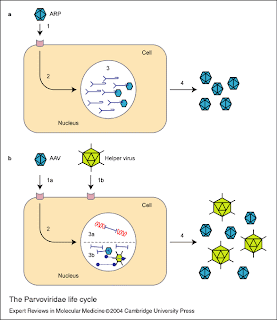Class II viruses are single stranded DNA viruses that replicate in the nucleus of the host cell to form a double stranded DNA. Single stranded DNA daughters come from these double stranded DNA.
An example of a virus from class II is Parvoviridae.
Parvoviridae
The Parvoviridae family includes the smallest known viruses, and some of the most environmentally resistant. They were discovered during the 1960s and affect vertebrates and insects.
The following genera are included here:

Subfamily Parvovirinae
• Genus Parvovirus; type species: Murine minute virus
• Genus Erythrovirus; type species: B19 virus
• Genus Dependovirus; type species: Adeno-associated virus 2
• Genus Amdovirus; type species: Aleutian mink disease virus
• Genus Bocavirus; type species: Bovine parvovirus
Subfamily Densovirinae
• Genus Densovirus; type species: Junonia coenia densovirus
• Genus Iteravirus; type species: Bombyx mori densovirus
• Genus Brevidensovirus; type species: Aedes aegypti densovirus
• Genus Pefudensovirus; type species: Periplanta fuliginosa densovirus
Parvovirus is a virus under the parvoviridae family, and it infects dogs. In puppies, infected puppies usually die within 24hours, while in adult dogs, the cases are mainly subclinical.
Virology
Genome
Parvovirus, commonly truncated to parvo, is a genus of the Parvoviridae family linear, non-segmented single stranded DNA viruses with an average genome size of 5 kbp. Parvoviruses are some of the smallest viruses found in nature. Some have been found as small as 23nm.
Replication

1. Virus penetrates into the host cell.
2. Uncoating, and release of the viral genomic ssDNA into the nucleus.
3. The ssDNA is converted into dsDNA by cellular proteins.
4. viral mRNAs are transcribed when host cell enters S phase and translated to produce viral proteins.
5. Replication occurs through rolling-hairpin mechanism, whith NS1 nickase binding covalently to the 5’ genomic end.
6. Individual ssDNA genomes are excised from replication concatemers by a process called junction resolution.
7. These newly synthesized ssDNA can either
a) be converted to dsDNA and serve as a template for transcription/replication
b) be encapsidated to form new virions that can bud out of the host cell.
Pathogenesis of Parvoviruses B19 Infection
B19 is associated with the following:-
1. Erythema infectiosum
2. Aplastic crisis in patients with chronic haemolytic anaemias.
3. Fetal loss in pregnancy
4. Persistent infection in immunocompromised patients
Clinical Features
Acute

• maculopapular rash
• slapped cheek appearance
• followed by joint involvement.
1. Erythema infectiosum
Two thirds of the cases resolve by 2 weeks and the majority by 4 weeks.
2. Aplastic Crisis;-
• occurs in patients with chronic haemolytic anaemia
• viral-like illness with fever and constitutional symptoms,
• followed by the onset of fatigue and anaemia.
• patient usually quickly recovers within a week, with the Hb recovering to normal levels. Such crises generally occur in children, and do not usually recur in an affected individual.
3. Infection in Pregnancy;-
increased fetal loss
4. Persistent infection in immunocompromized patients -
persistent infection resulting in severe anaemia in the immunocompromised
Diagnosis
• Serological tests
Aplastic crisis in a patient diagnosed by finding a reduction in Hb of >= 2g and a reticulocyte count of less than 0.2%
• Detection of Virus;- fetal blood samples or autopsy material where DNA-DNA hybridization and PCR can be carried out.
• Antibody Detection;- Counter-immunoelectrophoresis using B19 virus as antigen, detects antibody of all classes.
• Class specific Ab may be detected by ELISA or RIA.
Treatment and Prevention
• Administration of HNIG in cases of persistent B19 infection in the immunocompromised.
• Symptomatic therapy for erythema infectiosum rarely necessary.
• Cases of aplastic crisis require transfusion of erythocytes until satisfactory Hb level is obtained
• susceptible patients with chronic haemolytic anaemias should be isolated from patients with B19 induced aplastic crisis
• Pregnancy should be allowed to proceed and carefully monitored
• At delivery examination of the cord blood for B19 IgM reveal whether the virus crossed the placenta.
Done by: Alyssa Huang
